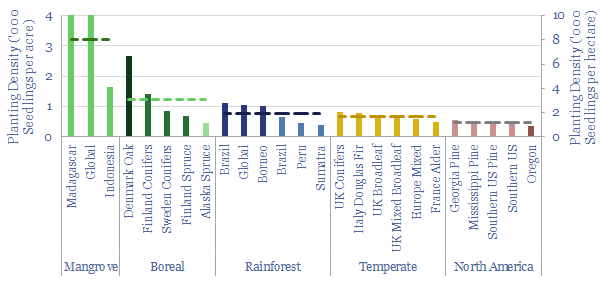What is the typical planting density for reforestation projects globally? This matters as it can determine the costs of reforestation. Hence in this data-file we have collated data from 25 different case studies globally, which have tended to plant a median of 670 seedlings per acre (1,650 per hectare). However, the range is broad, from 400 seedlings per acre in low-density Southern US forestry to 4,000 seedlings per acre in mangrove restoration projects.
Planting density depends on forestry practices, because as trees grow, they compete more for light, water and nutrients. Hence starting with a higher stand density will tend to require more thinning to avoid over-crowding and weak trees. Conversely, starting with a lower stand density will under-utilize valuable land in early years.
Planting density depends on forestry objectives. Dense stands may favor early harvesting, which is fine when growing crops for pulp, paper, wood-based fuel or lower-value sawlogs. However less dense stands may favor longer growing cycles, to produce high value timber, locking carbon away in long-lived construction materials.
Planting density depends on species. For example, mangroves are famously dense-growing. European pine and spruce forests can also be very dense (minimal branching). Whereas large broadleaves can be very extensive if grown to 100+ years.
Planting density depends on climate. For example, some rainforest reforestation projects have favored dense planting, to prevent slower growing trees from being outcompeted by fast-growing jungle plants. Conversely, Southern US forestry has some of the lowest planting density, falling by over 80% in the past 50-years, as survival has become better and better, averaging 88%.
Planting density depends on seedling cost. Another study notes that planting density can be optimized, year by year, depending on the costs of seedlings, favoring lower densities (and less subsequent thinning) to mute the impacts of seedling shortages.

